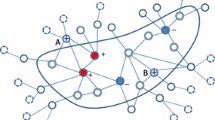Abstract
In addition to being rich material for successful deep learning, recent rapidly exploding big data needs more sophisticated direct approaches such algorithms that are expected to run in sublinear or even constant time. In view of this situation, property testing, which has been extensively studied in recent theoretical computer science areas, has become a promising approach. The basic framework of property testing is to decide with some inaccuracy if the input data have a certain property or not by reading only some fraction of the input. Especially, for the property testing of graphs, the hyperfiniteness of graphs plays an important role, which guarantees that any graph property can be testable. This hyperfiniteness requires graphs to have a partition that satisfies some conditions, and a property testing on algorithms that are run on those partitioned graphs. In this paper, we try to obtain such ideal partitions that satisfy hyperfiniteness by implementing an efficient partition algorithm recently proposed by Levi and Ron [ACM TALG, 2015]. Our experiments are performed mainly on real-world networks with the aim of bringing the theoretical results of property testing into practical use for big data analyses. As a result, we observed what would be effective for some classes of networks, which suggests great prospects of property testing in practice.




Similar content being viewed by others
Notes
We say that a graph \(G = (V, E)\) follows power-law if for the positive real number of \(c>1\) and \(\gamma > 1\), \(\mu _i \le c\cdot |V|\cdot i^{-\gamma }\) for all i, where \(\mu _i\) is the number of vertices of degree i
References
Albert, R., & Barabási, A. L. (2002). Statistical mechanics of complex networks. Rev. Mod. Phys., 74, 47–97.
Alon, N., Fischer, E., Krivelevich, M., & Szegedy, M. (2000). Efficient testing of large graphs. Combinatorica, 20, 451–476.
Alon, N., Fischer, E., Newman, I., & Shapira, A. (2009). A combinatorial characterization of the testable graph properties: It’s all about regularity. SIAM J. Comput., 39(1), 143–167.
Alon, N., Seymour, P., & Thomas, R. (1990). A separator theorem for graphs with an excluded minor and its applications. In: Proceedings of the twenty-second annual ACM symposium on theory of computing (STOC), pp. 293–299.
Benjamini, I., Schramm, O., & Shapira, A. (2008). Every minor-closed property of sparse graphs is testable. In: Proceedings of the fortieth annual ACM symposium on theory of computing (STOC), pp. 393–402.
Blum, M., Luby, M., & Rubinfeld, R. (1993). Self-testing/correcting with applications to numerical problems. Journal of Computer and System Sciences, 47(3), 549–595.
Cohen-Steiner, D., Kong, W., Sohler, C., & Valiant, G. (2018). Approximating the spectrum of a graph. In: Proceedings of the 24th ACM SIGKDD international conference on knowledge discovery & data mining, KDD ’18, pp. 1263–1271. ACM, New York, NY, USA. https://doi.org/10.1145/3219819.3220119.
Czumaj, A., Monemizadeh, M., Onak, K., & Sohler, C. (2011). Planar graphs: random walks and bipartiteness testing. In: IEEE 52nd annual symposium on foundations of computer science (FOCS), pp. 423–432.
Elek, G. (2008). L2-spectral invariants and convergent sequences of finite graphs. Journal of Functional Analysis, 254(10), 2667–2689.
Goldreich, O. (Ed.). (2010). Property testing: current research and surveys. Lecture notes in computer science (Vol. 6390). Berlin: Springer.
Goldreich, O. (2017). Introduction to property testing. Cambridge: Cambridge University Press.
Goldreich, O., Goldwasser, S., & Ron, D. (1998). Property testing and its connection to learning and approximation. Journal of the ACM, 45(4), 653–750.
Goldreich, O., & Ron, D. (1997). Property testing in bounded degree graphs. In: Proceedings of the twenty-ninth annual ACM symposium on theory of computing (STOC), pp. 406–415. ACM.
Hassidim, A., Kelner, J.A., Nguyen, H.N., & Onak, K. (2009). Local graph partitions for approximation and testing. In: 50th annual IEEE symposium on foundations of computer science (FOCS), pp. 22–31.
Ito, H. (2016). Every property is testable on a natural class of scale-free multigraphs. In: P. Sankowski, C. Zaroliagis (eds.) 24th annual European symposium on algorithms (ESA), Leibniz International Proceedings in Informatics (LIPIcs), vol. 57, pp. 51:1–51:12.
Kusumoto, M., & Yoshida, Y. (2014). Testing forest-isomorphism in the adjacency list model. In J. Esparza, P. Fraigniaud, T. Husfeldt, & E. Koutsoupias (Eds.), Automata, languages, and programming (ICALP) (pp. 763–774). Berlin Heidelberg: Springer.
Levi, R., & Ron, D. (2015). A quasi-polynomial time partition oracle for graphs with an excluded minor. ACM Trans Algorithms, 11(3), 24:1–24:13.
Lipton, R.J., & Tarjan, R.E. (1977). Applications of a planar separator theorem. In: Foundations of computer science, 1977., 18th annual symposium on, pp. 162–170. IEEE.
Marko, S., & Ron, D. (2009). Approximating the distance to properties in bounded-degree and general sparse graphs. ACM Transactions on Algorithms, 5(2), 22:1–22:28.
Newman, I., & Sohler, C. (2011). Every property of hyperfinite graphs is testable. In: Proceedings of the forty-third annual ACM symposium on theory of computing (STOC), pp. 675–684.
Sanders, P., & Schulz, C. (2013). Think Locally, Act Globally: Highly Balanced Graph Partitioning. In: Proceedings of the 12th International Symposium on Experimental Algorithms (SEA’13), LNCS, vol. 7933, pp. 164–175. Springer
Acknowledgements
This work was partially supported by JST CREST JPMJR1402.
Author information
Authors and Affiliations
Corresponding author
Additional information
Publisher's Note
Springer Nature remains neutral with regard to jurisdictional claims in published maps and institutional affiliations.
This work is supported by JST CREST Grant Number JPMJCR1402, Japan. This work is also supported by JSPS KAKENHI Grant Number 15K11985 and 17K00017.
Rights and permissions
About this article
Cite this article
Honda, Y., Inoue, Y., Ito, H. et al. Hyperfiniteness of Real-World Networks. Rev Socionetwork Strat 13, 123–141 (2019). https://doi.org/10.1007/s12626-019-00051-3
Received:
Accepted:
Published:
Issue Date:
DOI: https://doi.org/10.1007/s12626-019-00051-3




